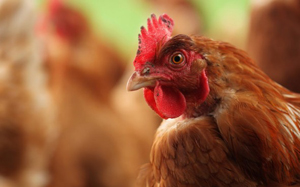Salmonella enteritidis (a paratyphoid Salmonella serotype) is a major food safety concern, primarily for the egg-laying industry. Possible sources in commercial layers include transmission from breeders, contaminated environments, infected rodents, and contaminated feed. Transmission to progeny from breeders is mainly through eggshell contamination, although, unlike other paratyphoid Salmonella , transovarial transmission may also occur. The NPIP now includes S enteritidis control measures in breeders, including depopulation of infected flocks, cleaning and disinfection of pullet and layer houses, extensive and improved rodent control programs, use of competitive exclusion products, vaccination, and proper handling and refrigeration of eggs.
Salmonella typhimurium , S enteritidis , and S heidelberg are among the most common salmonella infections in poultry, although infections may be produced by 10-20 different serotypes in the USA. Some species or strains are more pathogenic than others. The prevalence of other species varies widely by geographic location and season. Infected birds remain carriers. Although not common, clinical signs are sometimes seen in young birds. Mortality is most often limited to the first few weeks of age. Depression, poor growth, weakness, diarrhea, and dehydration are hallmarks of the disease, although these clinical signs are not distinctive. Lesions may include an enlarged liver with focal necrosis, unabsorbed yolk sac, enteritis with necrotic lesions in the mucosa, and cecal cores. Infections occasionally localize in the eye or synovial tissues.
Salmonella Enteritidis Antibody Test Kit is used for quantitative detection of antibodies against Salmonella enteritidis in chicken serum and egg yolk.
Inactivated antigen is bound to a microwell. Diluted sera is added to the microwell and incubated. Any anti-SE antibodies present in the serum will bind to the SE on the microwell forming an SE antigen-antibody complex. After washing away any unbound material, anti-Chicken IgG Alkaline Phosphatase conjugate is added to the microwell. The conjugate will bind to the SE antigen-antibody complex. After incubation any unbound conjugate is removed by washing. Enzyme substrate is then added to the microwell. The substrate reacts with any Alkaline Phosphatase present and forms a yellow product. In the final step the reaction is stopped, fixing the color. The intensity of the color is measured photometrically at 405 - 410 nm with a 630-650 nm reference filter.




